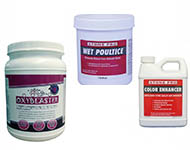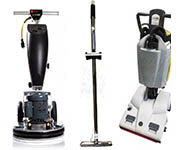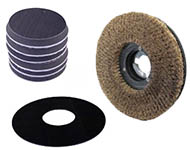Stone floor care is rock solid work
Don’t get stuck between a rock and a hard place. Learn how to perform stone floor care.
By Taf Baig
From the February 2003 edition of Cleanfax magazine.
As the sales of hard surfaces increase, carpet cleaning companies must decide whether to expand into this new field or stay with the services they already offer. There’s a variety of hard surfaces, but some of the most common and most profitable include:
- Natural stones, such as marble, granite, terrazzo and natural clay stones
- Man-made tiles, such as fire-hardened ceramic, porcelain and Italian quarry
We will also talk about tiles installed on floors, versus tiles installed on walls and countertops.
The natural
Tiles have been around for centuries and the elegance of natural stone is on display in more homes and commercial buildings especially with the advent of new technology to cut and transport natural stones into smaller sizes that are easier to handle.
Before 1970, there were very few natural stones because they were only cut in large slabs and found in expensive commercial buildings and very exclusive homes. Since 1970, however, more people have installed natural stones. These surfaces gradually lose their polished looks and need intensive cleaning, restoration and protection.
Floor machines are effective at shining many types of stone flooring. Property owners have learned how to handle daily cleaning and maintenance, but most aren’t proficient enough or don’t have the tools to perform polishing and restoration.
That’s where a carpet cleaning professional fits in. There are three main categories of natural stones:
1. Sedimentary stones come from such organic elements as glaciers, rivers, wind, oceans and plants. Tiny sedimentary pieces break off from these elements and accumulate to form rock beds. They are bonded through millions of years of heat and pressure and include limestone, sandstone and travertine.
2. Metamorphic stones come from a natural change from one type of stone to another through the mixture of heat, pressure and minerals. The change can be a development of crystalline formation, a texture change or even a color change. Marble and slate are metamorphic stones.
3. Igneous stones come from volcanic material such as magma. Liquid magma cools and solidifies underneath the Earth’s surface, then mineral gases and liquids penetrate the stone and create new crystalline formations and various colors. Granite is an igneous stone.
Marvel at marble
The most common natural stone is marble. It’s a metamorphic stone that is created from the recrystallization of limestone. Marble is also porous, which is important to know when cleaning. If water is left standing on marble, it will eventually go through the stone.
To visually distinguish marble from other stones, marble has veins, while granite has grains and travertine has holes, which may be filled at the factory. Marble is softer than granite and scratches more easily.
You can do most daily marble cleaning with commonly available stone soaps, which are designed to clean and protect. For heavy traffic areas, you may need to crystallize, or buff the tile with a liquid crystallizer, to bring out the shine.
Crystallization also puts on a protective layer that reduces scratching. Crystallization can produce phenomenal results when used in the right situation.
Since marble is softer, it is more prone to scratching, but if you grind marble every time it produces scratches, you?ll soon grind too thin. If there are light scratches, use restoration paste/powder with a weighted floor/bonnet machine. This will finely grind the surface to remove the minor scratching and also give it a nice shine.
If more shine is required, protect the surface with an impregnator to keep the stain from becoming permanent, then crystallize.
Removing medium to heavy scratches from marble is also necessary. If the marble is installed in a heavy traffic area or has aged so much that it has lost its original look. (To learn more about grinding marble, see True grit in the sidebar.)
Take it for granite
Granite is another common natural stone. It used to be classified as igneous rock derived from molten masses of magmas. Evidence now shows that some granites may have originated through regional metamorphism or preexisting rocks, rearrangement and recrystallization without a liquid or molten stage.
The main ingredients of granite are feldspars and quartz. It also is porous, and standing water will go through more slowly than through marble. Due to its chemistry, granite is a much harder stone. It doesn’t scratch as easily and rarely needs heavy-duty grinding. If it does, use an even heavier-duty machine than on marble.
Like marble, you can remove most light scratches on granite with granite restoration powder/paste. Use a weighted floor machine and a steel wool pad. The steel wool pad creates the heat necessary to shine and brighten dull surfaces. This is a good time to clean with a high-pressure cleaning tool, as it will also clean the grout. Clean daily with any good neutral floor cleaner made for natural stones.
Bon giorno, terrazzo
Terrazzo is a combination of stone and cement (epoxy, etc). It’s extremely durable and contains marble chips and other stones. Since it often contains marble, treat it as marble. For finishing purposes, you?ll mostly wax or strip and refinish with fresh wax.
Limestone is a sedimentary rock composed of calcium carbonate and possibly a varying percentage of magnesium. The most common limestones in the United States are re-crystallized ones that can take a polish like marble.
Travertine is a variety of limestone that has a partly crystalline or microcrystalline texture. Travertine has holes that may or may not be filled using some form of epoxy. Limestone and travertine are similar to marble for cleaning purposes. Since limestone is the softest of these stones, use lower pressure when cleaning it.
Fossilstone is considered a limestone that contains natural fossils such as seashells and plants. Sandstone is a sedimentary rock consisting of sheets of stone deposited on top of another underwater. Sandstones are rarely seen since they don’t do well with climatic elements.
More common are quartzites that are a highly crystallized sparkling form of sandstones. Sub-classifications of quartzite include flagstone, brownstone and bluestone.
(To learn about natural clay tiles, see Clean slate in the sidebar.)
Man-made popularity
The most popular man-made tiles are ceramic, porcelain and Italian quarry. They’re also the easiest to clean. If you’re doing hard surface cleaning for the first time, start with these types of tiles because there’s not much you can do to mess them up.
(To learn why grout makes cleaning tile challenging, see All about grout? in the sidebar.)
Ceramic tiles are made from clay that has been hardened by heat. They can be glazed or unglazed, slick or rough. They are not porous. Porcelain tiles are more dense, heavier-duty and mostly found in commercial settings.
Italian quarry tile is common in slippery areas, such as kitchens and bathrooms. They are unglazed to increase slip resistance.
Mosaic tiles are smaller than four inches. They’re used around drains or where surfaces are uneven.
Taf Baig is the founder of Magic Wand Company, a manufacturer and distributor of carpet cleaning tools, equipment and supplies. He is also the founder of a very successful carpet and furniture cleaning company. He owns patents for several tools and pieces of equipment. To e-mail him, visit www.magicwandco.com.
No products were found matching your selection.




